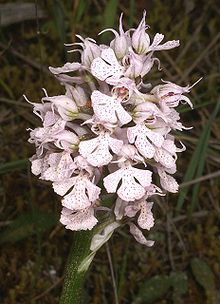Orchidoideae
This article includes a list of general references, but it lacks sufficient corresponding inline citations. (March 2018) |
| Orchidoideae | |
|---|---|

| |
| Neotinea tridentata subsp. commutata | |
| Scientific classification | |
| Kingdom: | Plantae |
| Clade: | Tracheophytes |
| Clade: | Angiosperms |
| Clade: | Monocots |
| Order: | Asparagales |
| Family: | Orchidaceae |
| Subfamily: | Orchidoideae |
| Tribes | |
|
See text | |

The Orchidoideae, or the orchidoid orchids, are a subfamily of the orchid family (Orchidaceae).
They typically contain the orchids with a single (monandrous), fertile anther which is erect and .
The subfamily Orchidoideae and the previously recognized subfamily Spiranthoideae are considered the closest allies in the natural group of the monandrous orchids because of;
- a shared terrestrial habit
- sectile (capable of being severed) or granular pollinia
- erect anthers.
The Orchidoideae contain (7 tribes and 3,630 species;[1] within two subclades with the following tribes :
- tribes Orchideae and Diseae
- tribes Cranichideae, Chloraeeae and Diurideae
The former subfamily Spiranthoideae is now embedded as tribe Cranichideae in the clade of the Orchidoideae. It is sister to the tribe Diurideae.
The tribe Orchideae (with 62 mostly terrestrial genera,[2]) comprises the following subtribes:
- Habenariinae[3]
- Orchidinae (1800 species in 47-60 genera,[4])
The tribe Diseae comprises the following subtribes:
The tribe Chloraeeae comprises the following subtribes:
The monophyletic tribe Cranichideae comprises the following monophyletic subtribes :
- Cranichidinae s.l. (including former Prescottiinae)
- Galeottiellinae
- Goodyerinae s.l. (including former Pachyplectroninae)
- Manniellinae
- Pterostylidinae
- Discyphinae
- Spiranthinae
The tribe Diurideae comprises the following subtribes :
- Acianthinae (monophyletic)
- Caladeniinae (polyphyletic)
- Cryptostylidinae (monophyletic)
- Diuridinae (monophyletic)
- Drakaeinae (monophyletic)
- Megastylidinae (monophyletic)
- Prasophyllinae (monophyletic)
- Rhizanthellinae (monophyletic)
- Thelymitrinae (monophyletic)
References[]
- ^ "Types of Orchids: A Visual Compendium". FTD.com. 1 March 2018. Retrieved 11 December 2021.
- ^ Inda, Luis A.; Pimentel, Manuel; Chase, Mark W. (July 2012). "Phylogenetics of tribe Orchideae (Orchidaceae: Orchidoideae) based on combined DNA matrices: inferences regarding timing of diversification and evolution of pollination syndromes". Annals of Botany. 110 (1): 71–90.
- ^ RICHARD M. BATEMAN; PETER M. HOLLINGSWORTH; JILLIAN PRESTON; LUO YI-BO; ALEC M. PRIDGEON; MARK W. CHASE (May 2003). "Molecular phylogenetics and evolution of Orchidinae and selected Habenariinae (Orchidaceae)". Botanical Journal of the Linnean Society. 142 (1). doi:10.1046/j.1095-8339.2003.00157.x.
- ^ Jin, Wei-Tao; Schuiteman, André; Chase, Mark W.; Li, Jian-Wu; Chung, Shih-Wen; Hsu, Tian-Chuan; Jin, Xiao-Hua (2017). "Phylogenetics of subtribe Orchidinae s.l. (Orchidaceae; Orchidoideae) based on seven markers (plastid matK, psaB, rbcL, trnL-F, trnH-psba, and nuclear nrITS, Xdh): implications for generic delimitation". BMC Plant Biology. 17: 222.
- ^ Chemisquy, M.A., Morrone, O. (2010) Phylogenetic analysis of the subtribe Chloraeinae (Orchidaceae): a preliminary approach based on three chloroplast markers. Australian Systematic Botany 23: 38-46. (Abstract)
- Pridgeon, A.M., P.J. Cribb, M.W. Chase and F.N. Rasmussen [eds.]. 2003. Genera Orchidacearum vol. 3: Orchidoideae part 2, Vanilloideae. Oxford University Press, Oxford, U.K.
- Salazar, G.A., M.W. Chase, M.A. Soto Arenas and M. Ingrouille. 2003. Phylogenetics of Cranichideae with emphasis on Spiranthinae (Orchidaceae, Orchidoideae): evidence from plastid and nuclear DNA sequences. American Journal of Botany 90: 777-795.
- Salazar, G.A., L.I. Cabrera, S. Madriñán and M.W. Chase. 2009. Phylogenetic relationships of Cranichidinae and Prescottiinae (Orchidaceae, Cranichideae) inferred from plastid and nuclear DNA sequences. Annals of Botany 104: 403-416. [1]
External links[]
| Wikimedia Commons has media related to Orchidoideae. |
| Wikispecies has information related to Orchidoideae. |
- Orchidoideae
- Asparagales subfamilies